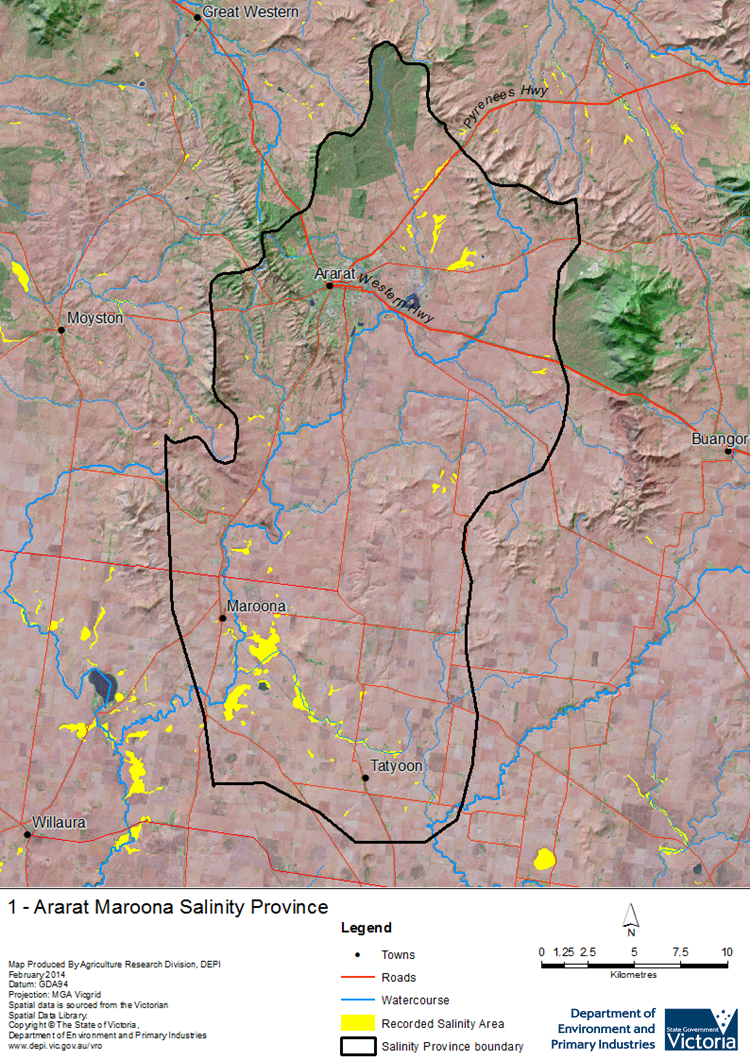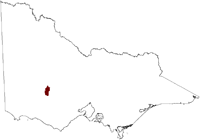Salinity Province 1, Ararat Maroona
|
|
Province Attributes
| Catchment Management Region: | GLENELG-HOPKINS |
| Priority Status: | High |
| Province Area: | 59,240 ha |
| Recorded Soil Salinity Area 1: | 911 ha |
| Dominant Surface Geology Type: | Sedimentary |
| Influence of Geological Structure on Salinity Occurrence/s: | None |
| Relevant Geomorphological Mapping Units (GMUs): | 2.1.X, 6.1.4 |
| Predominant Groundwater Flow Systems (GFSs): | Local/Intermediate |
| Relevant Irrigation Areas: | N/A |
Ararat Maroona Salinity Province Map

Links to further reading and material related to the Glenelg Hopkins Salinity Province
Groundwater Flow Systems (GFS) in the Glenelg Hopkins CMR
For further information relating to groundwater levels and salinities in this Province please see: Visualising Victoria's Groundwater (VVG)
1 Please Note: The ‘Recorded Soil Salinity Area’ indicated in the Salinity Province Attribute Table, comprises the total geographic area that has been mapped as having, or showing symptoms of, dryland soil salinity at some time (past or present). As dryland salinity occurrence in the Victorian landscape exhibits many different levels of severity and can change due to climate, landuse and vegetation, previously mapped areas may no longer be showing symptoms. In addition, as not all parts of the State have been mapped, or mapped in the same way, the mapping may not have captured some occurrences.
The soil salinity mapping used to calculate this ‘area’ does not cover irrigation regions. In irrigation regions, depth to watertable and watertable salinity mapping has been used to convey the threat of high watertables on soil waterlogging and/or soil salinisation and these areas are not included in this ‘area‘ calculation.
Please contact the Department, your Catchment Management Authority or your rural water provider for more information about salinity in your location.

 The Ararat_Maroona Salinity Province has a scattered distribution of salinity occurrence with the major concentration around the township of Maroona and northeast of Ararat. Some minor urban salinity is also found on low-lying areas of the Ararat township. The majority of the geology is meta-sedimentary fractured rock with some recent alluvial deposits. Most of the just over 900 ha of mapped salinity occurs on the alluvial deposits driven by local and intermediate scale Groundwater Flow Systems in the underlying fractured rock aquifer.
The Ararat_Maroona Salinity Province has a scattered distribution of salinity occurrence with the major concentration around the township of Maroona and northeast of Ararat. Some minor urban salinity is also found on low-lying areas of the Ararat township. The majority of the geology is meta-sedimentary fractured rock with some recent alluvial deposits. Most of the just over 900 ha of mapped salinity occurs on the alluvial deposits driven by local and intermediate scale Groundwater Flow Systems in the underlying fractured rock aquifer. 
